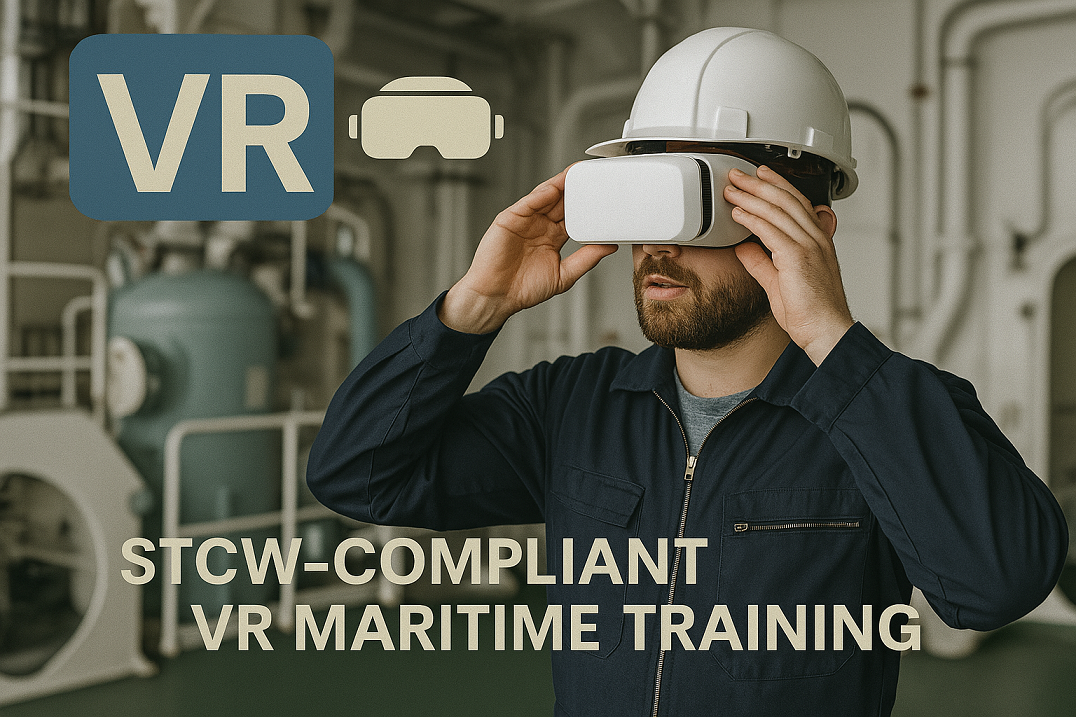Discover how STCW-compliant VR maritime training is revolutionizing seafarer education. Learn how virtual reality enhances safety drills, engine simulations, and competency-based learning in line with IMO standards.

Introduction
Can you perform a lifeboat drill or tackle an engine fire—all from a classroom? With virtual reality (VR), you can.
In the fast-evolving maritime sector, STCW-compliant VR training is becoming an essential tool to modernize seafarer education, improve safety, and enhance simulation-based learning. By integrating virtual reality with STCW (Standards of Training, Certification and Watchkeeping) frameworks, cadets and professionals can now train in high-risk environments—safely, realistically, and repeatedly.
This article explores how VR is transforming STCW training, offering insights for maritime students, cadets, ship officers, educators, and shipping companies.
What Is STCW-Compliant VR Maritime Training?
STCW-compliant VR maritime training refers to immersive, virtual reality-based learning experiences that meet the safety and competency standards outlined in the STCW Convention. These include:
-
Basic Safety Training
-
Advanced Firefighting
-
Personal Survival Techniques
-
Engine Room Resource Management
-
Bridge Operations and Watchkeeping
VR platforms are programmed to simulate IMO-approved training modules, ensuring learners gain the necessary skills, knowledge, and proficiency (KUPs) in realistic, scenario-based environments.
🧠 Keyword Focus: “STCW-compliant VR training” is now trending in maritime education circles, especially in institutions adopting digital transformation.
Why STCW-Compliant VR Training Matters
Traditional Challenges in Maritime Training:
-
High operational costs for physical simulators
-
Risk of injury during real-life drills
-
Limited access to real shipboard equipment for cadets
-
Inconsistent quality across training centers
How VR Solves These Challenges:
-
Immersive Experience: Trainees engage in hands-on practice through interactive 3D environments
-
Safe Repetition: Critical procedures like launching lifeboats or extinguishing engine fires can be practiced multiple times
-
Scalable & Portable: VR headsets and software can be deployed globally with minimal infrastructure
-
Real-Time Feedback: AI monitors and evaluates trainee performance, improving competency assessments
📊 Fact: According to the World Maritime University (WMU), VR-enhanced training improves knowledge retention by up to 75%, compared to 10% with traditional lectures.
Key Applications of STCW VR Training
1. Basic Safety & Survival Techniques
-
Fire response simulation (Class A, B, and electrical fires)
-
Abandon ship drills and life raft launching
-
Personal protective equipment (PPE) protocols
-
Cold water immersion exercises
2. Engine Room Simulations
-
Fault detection in pumps, generators, boilers
-
Fuel management and emergency shutdowns
-
Alarms and system failure response
-
Team coordination under Engine Room Resource Management (ERRM)
3. Bridge Watchkeeping & Navigation
-
Collision avoidance scenarios (COLREGs)
-
Radar and ECDIS operations in adverse weather
-
Lookout procedures and handover responsibilities
-
Integrated Bridge System (IBS) simulations
4. Emergency & Crisis Management
-
Firefighting leadership drills
-
Crowd control in passenger ships
-
Hazardous cargo incident response
-
Man overboard search-and-rescue coordination
🚢 Example: Kongsberg Digital’s K-Sim VR and Seably’s immersive STCW modules are already approved and used by academies globally.
The Benefits of STCW-Compliant VR Training
| Feature | Benefit for Maritime Training |
|---|---|
| Realistic Scenario Repetition | Builds muscle memory and faster decision-making |
| Standardized Training Quality | Ensures global STCW compliance regardless of location |
| Reduced Operational Costs | Less reliance on expensive physical simulators or ship visits |
| Remote Learning Capabilities | Ideal for distant or pandemic-affected institutions |
| Improved Record Keeping | Auto-generated performance data supports audits and evaluations |
💡 Instructor’s Tip: VR platforms are increasingly integrated with LMS (Learning Management Systems), allowing trainers to monitor progress and generate STCW documentation automatically.
Latest Trends and Future Outlook
| Emerging Innovation | Impact |
|---|---|
| Haptic Feedback Gloves | Enables tactile sensation (e.g., feeling resistance when turning valves) |
| Multiplayer VR Drills | Allows group coordination and leadership training in simulated emergencies |
| AI-Driven Assessment Engines | Evaluates accuracy, timing, and communication for STCW certification |
| Cloud-Based VR Training Centers | Offers global access to STCW courses for seafarers in remote regions |
| Metaverse Integration | Merges VR with virtual campuses, career guidance, and networking |
🧭 Forecast: By 2030, more than 60% of STCW training worldwide is expected to incorporate VR or mixed reality components.
FAQs: People Also Ask
Is VR training approved under STCW?
Yes. As long as the VR training aligns with IMO model courses and is delivered by certified institutions, it can be used for STCW competencies and refreshers.
How do trainees get assessed in VR environments?
AI or instructor-led assessment tracks:
-
Decision-making accuracy
-
Time to respond
-
Correct sequence of actions
-
Communication effectiveness
Can VR replace physical simulators entirely?
VR can complement or partially replace physical simulators for certain modules but cannot yet fully substitute bridge or engine simulators for advanced licensing levels (e.g., OOW or COC).
Is VR training affordable for maritime schools?
Yes. With falling hardware costs and cloud-based VR systems, many institutions can now adopt cost-effective, scalable solutions.
Conclusion: Immersive Learning for a Safer Sea
STCW-compliant VR maritime training is not just a trend—it’s the new standard for safety, efficiency, and modern maritime education. By blending immersive technology with regulatory compliance, it helps seafarers prepare for real-world challenges with confidence and competence.
⚓ Call to Action: If you’re a cadet, instructor, or training provider, explore STCW-certified VR platforms and integrate them into your learning journey. The future of maritime safety is not just on board—it’s also virtual.

